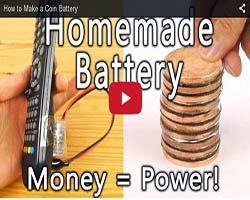Making a lemon battery is very easy. Lemon contains citric acid and with the help of citric acid two different metals can generate electricity. You will need lemon, copper coin, zinc coated nail, crocodile clip, multimeter and a LED to make battery. It can be a science fair project also. So watch this hilaroad video… Read the rest
Category Archives: Science
Sleeping in space
How do astronauts sleep in space? It’s little different. Astronauts feel virtually weightless there and a sleeping astronaut may float away from one end of space station to other end. So they sleep inside a sleeping bag which is attached to the space station. Astronaut Chris Hadfield explains in this video.… Read the rest
Battery from coin
It’s a very simple experiment to generate electricity from copper coins and I bet you will enjoy. This copper coin battery can light LED, can power your TV remote controller. Along with ten copper coins you will need cardboard, foil, vinegar, salt water, scissors, plastic tape and a LED to check whether your battery is… Read the rest
Build your own windmill
Windmill can convert wind energy into rotational energy and eventually this rotational energy can be converted to electricity. Rotating windmill rotates an electric generator from where electricity is generated. It’s a simple experiment video by hilaroad to show how you can make a windmill and calculate its power.… Read the rest
Are MRIs safe?
Ionizing radiation like X-ray can be harmful. But to date no study has claimed that MRI is harmful. Instead of radiation a giant magnet is used to take image of body parts inside which may be your brain, heart or anything. One danger of MRI is its strong magnet attracts metal. So technicians ensure no… Read the rest
How much sugar is added to a can?
Excessive sugar is never a good thing. Perhaps you can’t imagine how much sugar is added to a can of soda or fruit drinks. It’s seven to eight tea spoon of sugar. Do you normally take this amount of sugar at home? Marshal Brain explaining this with an experiment which you can do at home.… Read the rest
Death-proof safety elevator
Today’s safety elevators don’t fall when cable breaks. A lock invented by American industrialist Elisha Otis locks the elevator while descending at high speed and hence prevents falling. This death defying elevator was introduced in 1852. Watch this discovery channel video to see how it was invented.… Read the rest
Solar & lunar eclipse explained
What is the difference between solar and lunar eclipse? Did you know a lunar eclipse on earth is like a solar eclipse on moon? Why lunar eclipse is so common compared to solar eclipse? You can watch lunar eclipse with naked eye, but not solar eclipse. Watch the video, physics girl explains all.… Read the rest
Carbon dioxide is heavier than air
Yes we all know that carbon dioxide is heavier than air, but how can we prove it? It can be proved with common chemicals found in kitchen. Reaction between baking soda (sodium bicarbonate) and vinegar produces carbon dioxide which can extinguish fire. Watch the simple experiment video and of course try at home!… Read the rest
Behavior of water in space
Canadian astronaut Chris Hadfield shows how water behaves in weightless environment of space station. He tries to wring out water from a wet wash cloth but because of surface tension water sticks with his hand like jelly and he uses another dry wash cloth to remove water from his hand.… Read the rest









